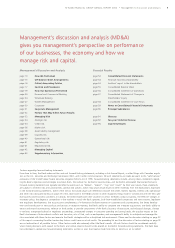TD Bank 2003 Annual Report Download - page 19
Download and view the complete annual report
Please find page 19 of the 2003 TD Bank annual report below. You can navigate through the pages in the report by either clicking on the pages listed below, or by using the keyword search tool below to find specific information within the annual report.TD BANK FINANCIAL GROUP ANNUAL REPORT 2003 • Management’s Discussion and Analysis 17
Accounting for securitizations
There are two key determinations relating to the accounting
for securitizations. For bank-originated securitized assets, a
decision must be made as to whether the securitization
should be considered a sale under Canadian GAAP. Canadian
GAAP requires that specific criteria be met for the Bank to
have surrendered control of the assets and thus recognize a
gain on sale. For instance, the securitized assets must be
isolated from the Bank and put beyond the reach of the Bank
and its creditors, even in bankruptcy or other receivership.
The second key determination is whether the special purpose
entity (SPE) should be consolidated into the Bank’s financial
statements. Current Canadian GAAP requires consolidation of
SPEs only when the Bank retains substantially all the residual
risks and rewards of the SPE. In addition, if the SPE’s activities
are sufficiently restricted to meet certain accounting require-
ments, the SPE should not be consolidated by the Bank.
Under current Canadian GAAP, all of the Bank-originated
assets transferred to SPEs meet the criteria for sale treatment
and non-consolidation. However, it should be noted that the
Canadian Institute of Chartered Accountants (CICA) has
issued a new accounting guideline entitled the Consolidation
of Variable Interest Entities (VIEs). The guideline introduces
a new consolidation model which determines control (and
consolidation) based on the potential variability of gains and
losses of the entity being evaluated. The guideline is effective
for the Bank beginning in fiscal 2005 and may result in
the consolidation of certain VIEs. See Note 26 of the Bank’s
Consolidated Financial Statements for more details.
Valuation of goodwill and intangible assets
Under Canadian GAAP, goodwill is not amortized, but is
instead assessed for impairment at the reporting unit level on
at least an annual basis. Goodwill is assessed for impairment
using a two step approach with the first step being to assess
whether the fair value of the reporting unit to which the
goodwill is associated is less than its carrying value. When
the fair value of the reporting unit is less than the carrying
value, a second impairment test is performed. The second
test requires a comparison of the fair value of goodwill to its
carrying amount. If the fair value of goodwill is less than its
carrying value, goodwill is considered impaired and a charge
for impairment must be recognized immediately. The fair
value of the Bank’s reporting units are determined from
internally developed valuation models that consider various
factors such as normalized and projected earnings, price
earnings multiples and discount rates. The Bank’s manage-
ment uses judgement in estimating the fair value of reporting
units and imprecision in estimates can affect the valuation
of goodwill.
Intangible assets that derive their value from contractual
customer relationships or that can be separated and sold,
and have a finite useful life are amortized over their estimated
useful life. Determining the estimated useful life of these
finite life intangible assets requires an analysis of the circum-
stances and judgement by the Bank’s management. Finite
life intangible assets are tested for impairment whenever
circumstances indicate that the carrying value may not be
recoverable. See Note 5 to the Bank’s Consolidated Financial
Statements for more details.
Accounting for pensions and post-retirement benefits
The Bank’s pension and post-retirement benefits obligation
and expense is dependent on the assumptions used in
calculating these amounts. The actuarial assumptions are
determined by management and are reviewed annually by
management and the Bank’s actuaries. These assumptions
include the discount rate, the rate of compensation increase,
the overall health care cost trend rate and the expected long-
term rate of return on plan assets. Differences between
actual experience and the assumptions will result in increases
or decreases in the Bank’s pension and post-retirement
benefits expense in future years. See Note 14 to the Bank’s
Consolidated Financial Statements for more details.
During the year, the Bank enhanced its internal controls over
financial reporting within Wholesale Banking through the
creation of a new Middle Office group with the mandate to
further develop cross-functional support for its derivatives
businesses and to focus on enhancing infrastructure and
controls. In addition, the Bank enhanced its controls in the
financial reporting process through a detailed review of
residual unallocated revenues and expenses in the Corporate
segment. During the 2003 fiscal year, there have been no
significant changes in the Bank’s internal controls over
financial reporting that have materially affected, or are
reasonably likely to materially affect the Bank’s internal
controls over financial reporting. However, the Bank is
continually improving its infrastructure and controls.
An evaluation was performed under the supervision and
with participation of the Bank’s management, including the
President and Chief Executive Officer (CEO) and Chief
Financial Officer (CFO), of the effectiveness of the design and
operation of the Bank’s disclosure controls and procedures, as
defined in the rules of the U.S. Securities and Exchange
Commission (SEC), as of the end of the period covered by
this Annual Report. Based on that evaluation, the Bank’s
management, including the CEO and CFO, concluded that
the Bank’s disclosure controls and procedures were effective
as of October 31, 2003.
Controls and Procedures
























